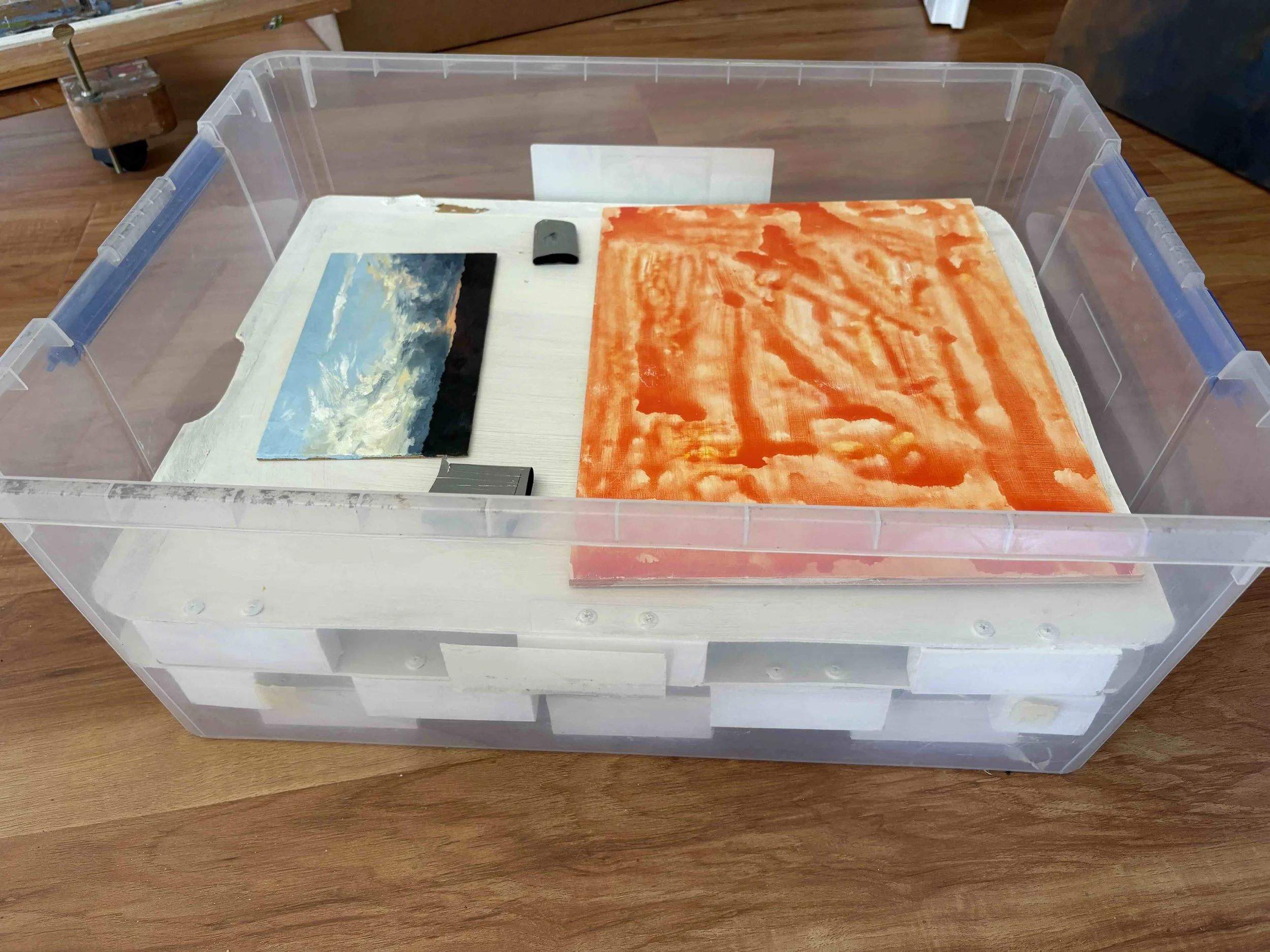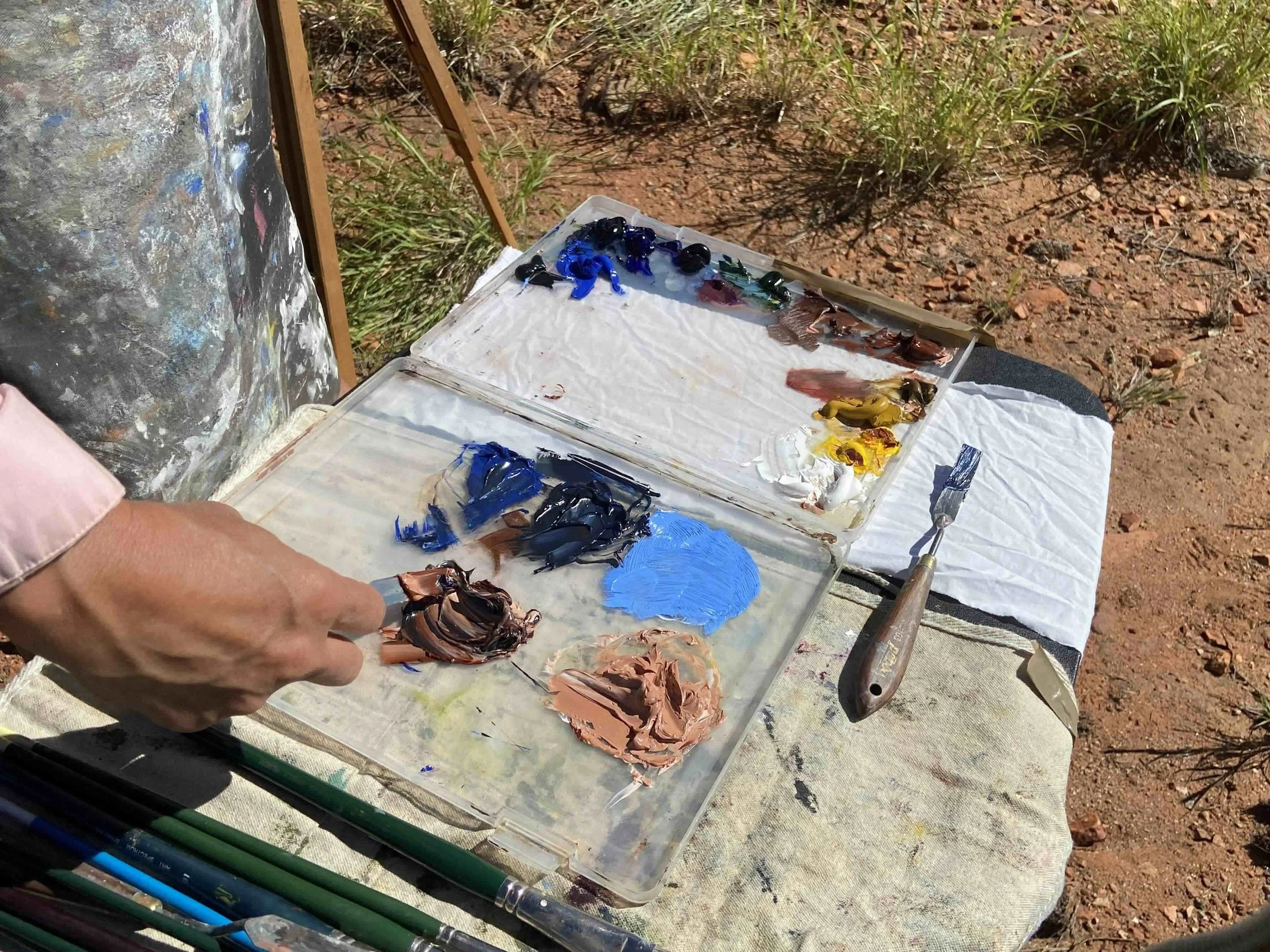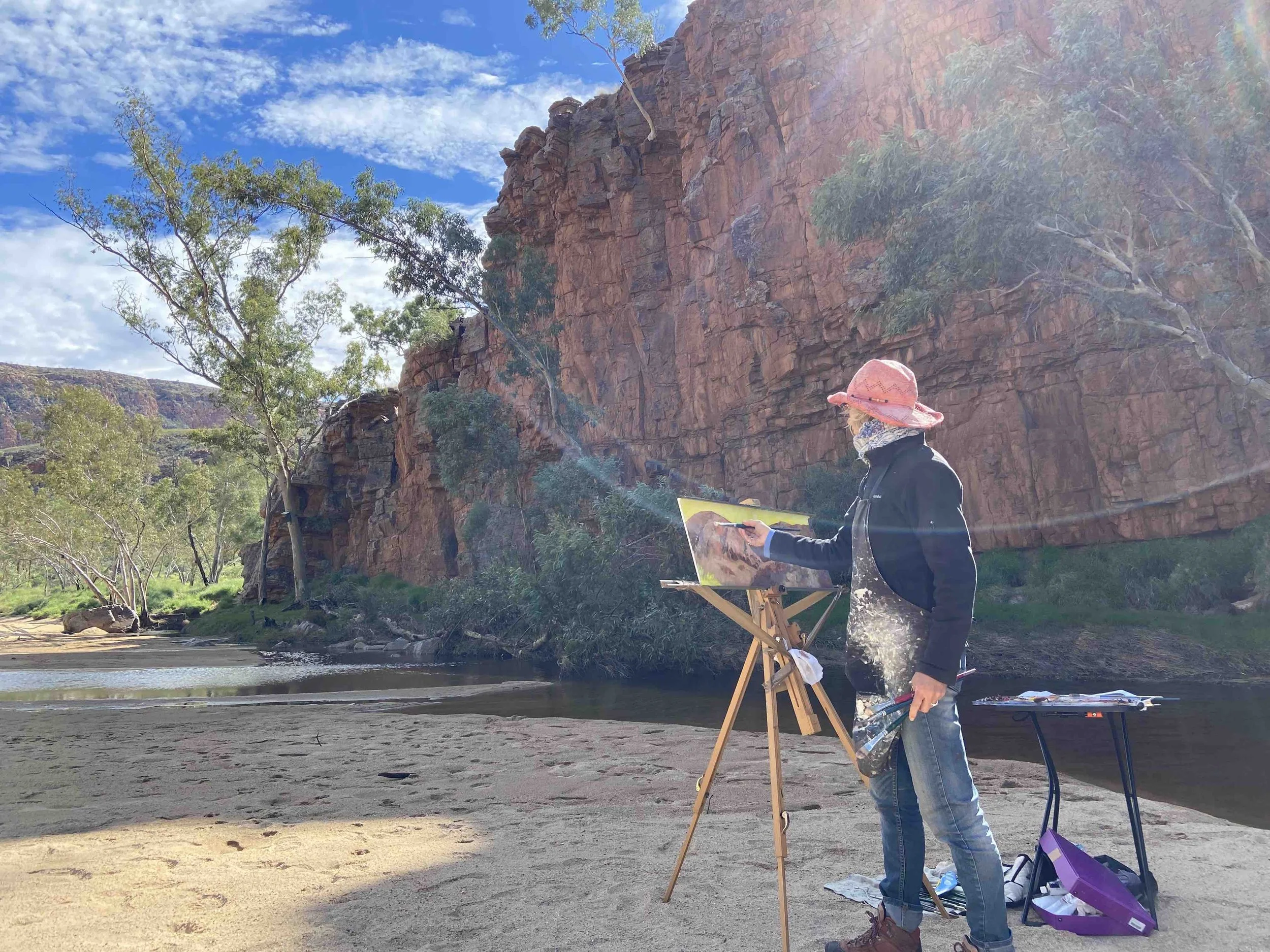Capertee 7-Day Painting Residency Information
7-Day Guided Artist Retreat
Where the Painting Residency Starts
The first day of your residency begins anytime from 9 am at Capertee Mountain View Retreats. You’re welcome to come and settle in, then get straight into painting or exploring in the area. The first mentoring session will take place late afternoon in the communal painting studio.
Capertee Mountain View Retreats is located at 1 Port Macquarie Rd, Bogee, in the Capertee Valley. Detailed directions can be found here.
Please note that there is limited mobile reception through the valley, so download the directions in advance. Generally, there is good coverage on site during the retreat.
What’s Included in Your 7-day Stay?
Independent painting practice — freedom to choose your own subjects and schedule.
Daily 1-hour small-group mentoring sessions with Corinne in the communal studio — practical tuition, critique, and problem-solving on painting technique, including composition, colour, subject matter etc.
Two private tutorials with Corinne — personalised feedback and mentoring to support your individual goals as an artist.
Feedback Circles — peer reviews facilitated by Corinne, designed to build confidence, skill and awareness
Flexible locations — paint in the Woolshed studio, outdoors around the property, or travel into the Capertee Valley, Wollemi or Capertee National Parks to paint en plein air.
Accommodation at Capertee Mountain View Retreats
What to Bring
Food
Self-cater in the fully equipped kitchens, cook over the fire or on the BBQ and/or enjoy the local restaurants at Rylstone, Kandos and Glen Alice.
Fridges, appliances, cooking utensils and equipment are available in Peppertree Cottage as well as the Hayshed communal kitchen. Each vintage van is also equipped with a fridge and a kettle.
Evenings are a highlight, connect with other artists with fireside conversation, food, and drinks.
General Equipment
Bring whatever helps you feel comfortable and creative, including:
Journal, pen, and pencil
Walking shoes and a rain jacket
Hat, sunscreen, and sunglasses
Warm clothing for cool evenings
Backpack and water bottle
Sheets and towels (can be provided as an optional extra)
Plein Air Painting Materials and Equipment
As an intermediate or advanced painter, you will have your own preferred colours, medium and painting setup. You’re encouraged to bring your own favourite materials and any you’d like to experiment and explore with — this residency is the perfect time to try new techniques and tools.
A limited number of easels are available for loan for the duration of your stay. Contact Corinne to request one.
For more detail, see Corinne’s article: The Art of Plein Air Painting – a guide to outdoor painting approaches and equipment.
The lists below are just a starting point for plein air painting - please supplement them according to your preference.
-
PAINT
I recommend Atelier Interactive acrylic 80 ml tubes in the following colours. They are widely available, even at Officeworks and Spotlight - and their prices are often cheaper than art shops.
Titanium White
Carbon Black
Cadmium Yellow Light / Arylamide Yellow Light
Cadmium red medium
Alizarin Crimson
French Ultramarine
Cerulean Blue / Pthalo Blue
Permanent Sap Green
Magenta
Burnt Umber
Yellow Ochre / Burnt Sienna
If you prefer to buy a set (as in below), then supplement with the following:
Black
Magenta
Cerulean / Pthalo Blue
Permanent Sap Green
Yellow Ochre / Burnt Sienna
Set contains: Titanium White, Burnt Umber, Arylamide Yellow Light, Cobalt Blue Hue, Napthol Red Light, Crimson
MEDIUMS - optional
Retarder medium slows drying and is especially useful outdoors
Impasto thickens paint - if you want to work with textured paint
SUPPORTS
You can purchase packs of ply or canvas boards or stretched canvases in a range of sizes, for example, 4 of 12” x 16”, 3 of 10” x 12” etc. I found the shape of the landscape invited long rectangular formats, and if you have several of the same sizes, you could potentially butt them up next to each other if you wish to. Good quality paper is also fine.
BRUSHES
I recommend buying 5-8 hog's bristle brushes and more synthetic ones in different sizes and shapes. The styles of brush seen most commonly are:
Round: sometimes a pointed tip, long closely arranged bristles for detail.
Flat: for spreading paint quickly and evenly over a surface. They have longer hairs than Brights.
Bright: shorter than flats. Flat brushes with short stiff bristles, good for driving paint into the weave of a canvas in thinner paint applications, as well as thicker painting styles like impasto work.
Filbert: flat brushes with domed ends. They allow good coverage and the ability to perform some detail work - most useful shape.
Fan: for blending broad areas of paint.
Angle: like the filbert, these are versatile and can be applied in both general painting application as well as some detail work.
Mop: a larger format brush with a rounded edge for broad soft paint application, washes as well as for getting thinner glazes over existing drying layers of paint without damaging lower layers to protect the paintbrush
EQUIPMENT
Sketchbook - A4 or larger
7 - 10 Canvases/Boards/or Canvas Paper ( I will supply 2)
Easel (if you don’t have one, let Corinne know to bring an extra one)
Brushes - bring a range of sizes and types
Palette knives - 2 to 3
Palette - A plastic clear document holder or clip board makes a great portable palette
Paints
Retarder medium - optional
Water
Jar to clean brushes
Paper towel/rags
Coloured/graphite pencil
Bulldog Clips
Apron
Baby wipes
Plastic bag
Hat
Folding chair
Small folding table
Sunscreen
Stanley knife/pencil sharpener
Spray bottle
Any other art materials you want to work in
Bubble wrap, glassine paper, old sheets or boxes to wrap your work for transportation.
-
PAINT
I recommend the following readily available sets of ART SPECTRUM 40 ml tubes (Windsor & Newton or Georgian are good substitutes):
Sets of 6 colours including: Spectrum Yellow, Spectrum Red, Spectrum Blue, Spectrum Viridian, Yellow Ochre, Titanium White
Sets of 9 colours including: Lemon Yellow, Spectrum Red, Spectrum Violet, Spectrum Blue, Spectrum Viridian, Yellow Ochre, Burnt Sienna, Raw Umber, Zinc White
If you would like to supplement either set add:
Black
Ultramarine Blue
Sap Green or Australian Leaf Green
MEDIUMS
The most versatile medium is Liquin. Not necessary to buy unless you want to try it.
SOLVENT
Bring Odourless Solvent and bring a spare jar to store dirty solvent for reuse
SUPPORTS
Bring a few sheets of canvas paper and a range of sizes of plywood or canvas boards or stretched canvases, for example, 3 of 12” x 16”, 2 of 10” x 12” etc. I found the shape of the landscape invited long rectangular formats, and if you have several of the same sizes, you could potentially butt them up next to each other if you wish to.
BRUSHES
BRING 7 - 10 hog's bristle brushes and a few synthetic ones in different sizes and shapes. The styles of brush seen most commonly are:
Round: sometimes a pointed tip, long closely arranged bristles for detail.
Flat: for spreading paint quickly and evenly over a surface. They have longer hairs than Brights.
Bright: shorter than flats. Flat brushes with short stiff bristles, good for driving paint into the weave of a canvas in thinner paint applications, as well as thicker painting styles like impasto work.
Filbert: flat brushes with domed ends. They allow good coverage and the ability to perform some detail work - I find this the most versatile brush.
Fan: for blending broad areas of paint.
Angle: like the filbert, these are versatile and can be applied in both general painting application as well as some detail work.
Mop: a larger format brush with a rounded edge for broad soft paint application, washes as well as for getting thinner glazes over existing drying layers of paint without damaging lower layers to protect the paintbrush
EQUIPMENT
Sketchbook - A4 or larger
Few sheets of canvas paper
7 - 10 Canvases or Boards ( I will supply 2)
Easel (if you don’t have one, let Corinne know you may be able to borrow one)
Brushes - bring a range of sizes and types
Palette knives - 2
Palette - A plastic clear document holder or clip board makes a great portable palette
Paints
Odourless Solvent and two glass jars with lids
Paper towel/rags
Coloured/graphite pencil
Bulldog Clips
Apron
Baby wipes
Plastic bag for keeping dirty rags
Hat
Folding chair
Small folding table
Sunscreen
Stanley knife/pencil sharpener
Any other art materials you may like to use…watercolours etc
Bubble wrap, glassine paper, old sheets or boxes to wrap your work for transportation. Please see photos below.
-
PAINT
Bare minimum:
• Spectrum Yellow - Art Spectrum brand (AS)
• Cadmium Red - Shminke brand (Sh)
• Ultramarine Blue (AS or Sh)
• Prussian Blue (AS or Sh)
Useful extras:
• Cerulean Blue (AS)
• Burnt Umber (Sh)
• Lemon Yellow (AS or Sh)
Other good brands - Rembrandt, Old Holland, Windsor and Newton, ( W&N have a cheaper student range of ‘Cottman’ watercolours as well as an artist-quality range.)
PAPER
100% Cotton paper - several single sheets or a pad of paper ( 10 sheets minimum) of the size you want - A4 or A3 depending on how quickly you work. We will also be doing some exercises for which you will need paper.
Good options: Arches 185 gsm or 300 gsm or Saunders Waterford 200 gsm
( Heavier weight paper is better, but 185 gsm is fine for small works up to A3)
Note - good 100% cotton paper is fairly expensive. You might be tempted to get wood pulp paper because it is cheaper. It is much harder to paint on. ( If it doesn’t say 100% cotton, it is most likely wood pulp.)
BRUSHES
3 sizes
Small - about size 3 round
Medium - size 8 - 10 round
Large - size 12 round or 3/4 “ inch flat brush
Mostly, students get synthetic brushes as they are more affordable.
HB pencil
Kneadable eraser ( putty rubber )
A palette of white plastic ( or cheap white plastic bowls ) to mix in.
Spray bottle
Mediums if you prefer
Easel (if you don’t have one, let Corinne know to bring an extra one)
Water
Jar to clean brushes
Paper towel/rags
Bulldog Clips
Apron
Baby wipes
Plastic bag for rubbish
Hat
Folding chair
Small folding table
Sunscreen
Stanley knife/pencil sharpener
Any other art materials you want to work in

Plein air painting near Alice Springs

A box system I use for storing wet oil paintings on the road.

Brush rolls are great to store and protect brushes

A plastic document holder that clips closed makes a light-weight and versatile palette

Plein air painting near Ormiston Gorge with portable folding table

Metal portable plein air painter's easel

Types of artist's brushes
Accommodation
Capertee Mountain View Retreats is a place for artists to reconnect with nature and their creativity. The farm offers paddocks to wander, cosy spots to relax, and beautiful, sweeping views to enjoy.
We offer comfortable rooms and various styles of accommodation to suit different budgets and preferences.
Stay in the farmhouse, in one of our restored vintage vans in the paddocks or even under the stars in your own tent or campervan.
To help keep accommodation costs to a minimum, we ask that you bring your own linen - sheets and towels. If you're travelling from afar or have luggage limitations, feel free to email and we’ll happily make special arrangements for you.
During and at the conclusion of the residency, you are kindly asked to maintain your room and participate in light shared housekeeping and farm tasks around the property. It’s all part of the community spirit that makes this experience so memorable.
Where you’ll sleep
Vintage Vans with Views
Stay in one of our delightfully restored and decorated vintage vans — Greta, Camilla, Poppy or Lizzie.
Each boasts a comfy double bed, private kitchenette, heating and cooling, outdoor seating, and beautiful paddock views.
Enjoy access to shared bathrooms, a fully equipped kitchen in the Hayshed, fire pits, the communal studio, and relaxed living areas.
Please bring your own double bed sheets and towels
Peppertree Farm Cottage
The cottage provides simple but elegant living spaces and bedrooms, a large kitchen, verandahs to catch the morning sun, a hearth for fireside games and conversation, and a spacious dining table for shared meals. Watch the horses and sheep graze and enjoy the mountain views in changing light and weather.
Room options include:
QB with Ensuite
QB, shared bathroom
DB in Twin-share, shared bathroom
SB in Twin-share, shared bathroom
Please bring your own sheets and towels
Paddock Camping
Bring your campervan, caravan, or tent and sleep under the stars with 360-degree valley views.
You’ll have access to shared bathrooms, a fully equipped kitchen, communal fire pit, studios, and shared living areas.
Accompanying Partner
If you would like your partner to accompany you at Capertee Mountain View Retreat, while you are on the artist residency, they are welcome to share your accommodation, join us at the fireside and soak up the beautiful surroundings. An additional accommodation/amenities fee of $250 is payable. Simply let us know on the booking form and a separate invoice will be sent.
Bringing Your Pet
Well-behaved dogs are welcome on residency, provided they are respectful and supervised, are kept off furniture, and are friendly with other dogs. Please bear in mind that dogs are not allowed in the Capertee or Wollemi National Parks. Approval must be requested in advance to bring your dog, please email Corinne.
About The Capertee Valley
The spectacular Capertee Valley, north of Lithgow, is part of the Greater Blue Mountains, NSW, and lies just 185 km from Sydney and 81 km from Mudgee.
It is most easily accessed by car, but you can also take the train to Lithgow on the Blue Mountains Line from Sydney, then connect by coach from Lithgow to Capertee and arrange a pickup to the farm (let us know on your booking form and we’ll contact you to confirm times).
Residents need to consider that the closest supermarket for supplies is in Kandos, which is 27 km from the farm.
Access detailed directions to Capertee Mountain View Retreats here.
Cost of Residency with Mentoring & 6 Nights Accommodation
Early bird rates:
Farmhouse
Queen Bed with ensuite — $1170
Queen Bed with shared bathroom — $1050
Double Bed in Twin-share, shared bathroom — $810
Single Bed in Twin-share, shared bathroom — $750
Vintage Caravans — Paddock Views
(4 available: Greta, Lizzie, Camilla, and Poppy)
Each van includes a comfy Double Bed, private kitchenette, heating & cooling, outdoor seating, and access to shared bathrooms and communal living & kitchen facilities — $810
Camping
Camping with own campervan, caravan or tent, with access to shared bathrooms and communal kitchen facilities — $630
Standard Rate
The standard rate - an additional 10%, applies to bookings or final payments made after 10 June 2026. An email reminder for the balance of the early bird is sent in May.
Partner Stay Contribution
$250 Accommodation & Amenities Fee
(Covers shared accommodation, facilities access, and communal activities.)
What People Say About the Retreats







